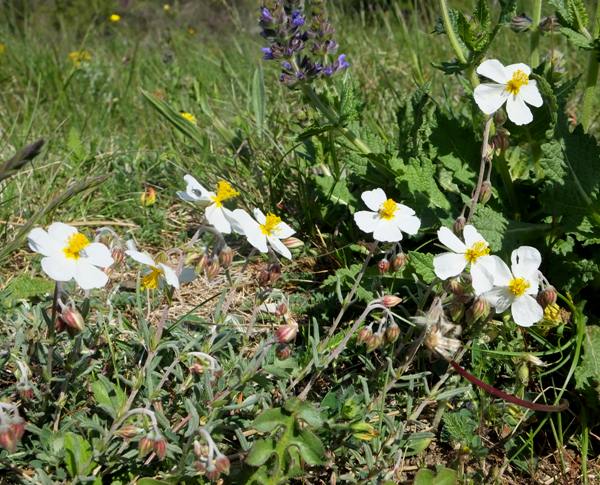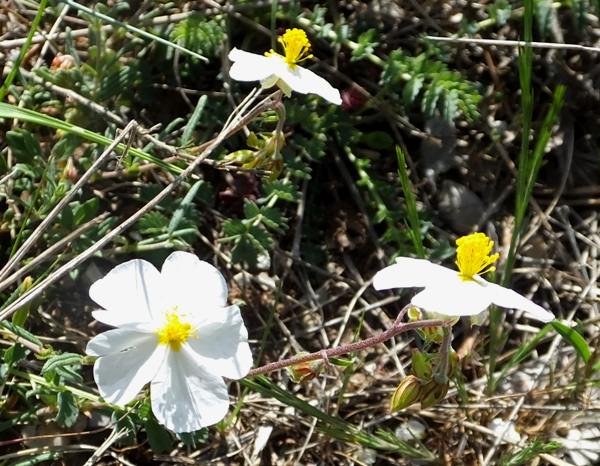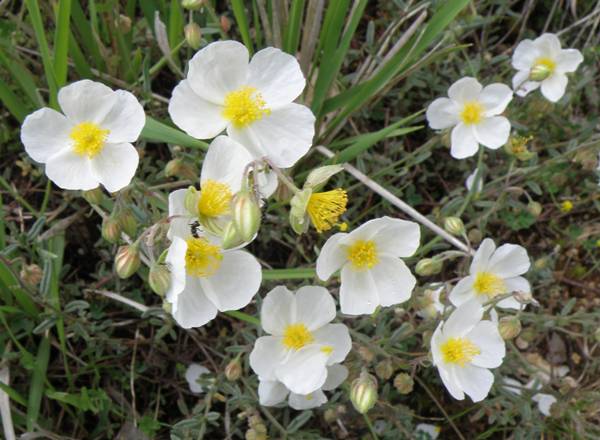Helianthemum apenninum - White Rock-rose
Phylum: Magnoliophyta - Class: Equisetopsida - Order: Malvales - Family: Cistaceae

White Rock-rose is a perennial, low-growing and sometimes almost prostrate wildflower, but now very rare and localised in Britain.

Description
This spreading plant grows to about 25cm in height. Its woody stems branch and are variably hairy. The white flowers, each with five touching or overlapping crinkled petals backed by shorter oval, ridged sepals, open in sunshine and close up at night - hence the genus name Helianthemum, which means 'sun flower'. The flowers are typically 25 to 30mm across and have strikingly yellow pollen borne on numerous splaying greenish anthers, while the thick downy lanceolate leaves, which are narrower than the leaves of Common Rock-rose, are curled at their edges and have deep central grooves.
Habitat
In Britain, as on mainland Europe, this wildflower is associated with dry alkaline soils such as limestone cliffs and shallow unimproved grassland overlying limestone in dry meadows and on sunny hillsides.

Distribution
In Britain, White Rock-rose is found only in a couple of areas in Somerset and Devon. On mainland Europe this member of the family Cistaceae occurs in many countries including Germany, Belgium, France, Spain, Portugal and Italy.
Blooming times
In Britain White Rock-rose produces flowers from late May through to early September, while in southern Europe the flowers appear as early as April.
Etymology
The specific epithet apenninum means 'of or from the appenines' - a reference to the mountain range that forms the backbone of Italy, where this rock-rose can indeed be found.
Similar species
Common Rock-rose Helianthemun nummularium has flowers with yellow petals and is very common in alkaline parts of Britain and Ireland.
Hoary Rock-rose Helianthemum oelandicum is also found mainly in limestone and chalk regions of Britain and Ireland; it starts flowering a month or so earlier than Common Rock-rose and its flowers are usually much smaller than those of Common Rock-rose.
In the Mediterranean region of Europe, Spotted Rock-rose Tuberaria guttata is very common; it has yellow petals with distinctive red patches at their bases.
Several other members of the Rock-rose family (Cistaceae) occur in the Mediterranean region include Cistus Albidus (Grey-leaved Cistus) and Cistus salviifolius (Sage-leaved Cistus).
The White Rock-rose specimens shown here were photographed in the Aveyron region of southern France during May and in Italy in early June.
Please Help Us: If you have found this information interesting and useful, please consider helping to keep First Nature online by making a small donation towards the web hosting and internet costs.
Any donations over and above the essential running costs will help support the conservation work of Plantlife, the Rivers Trust and charitable botanic gardens - as do author royalties and publisher proceeds from books by Pat and Sue.

